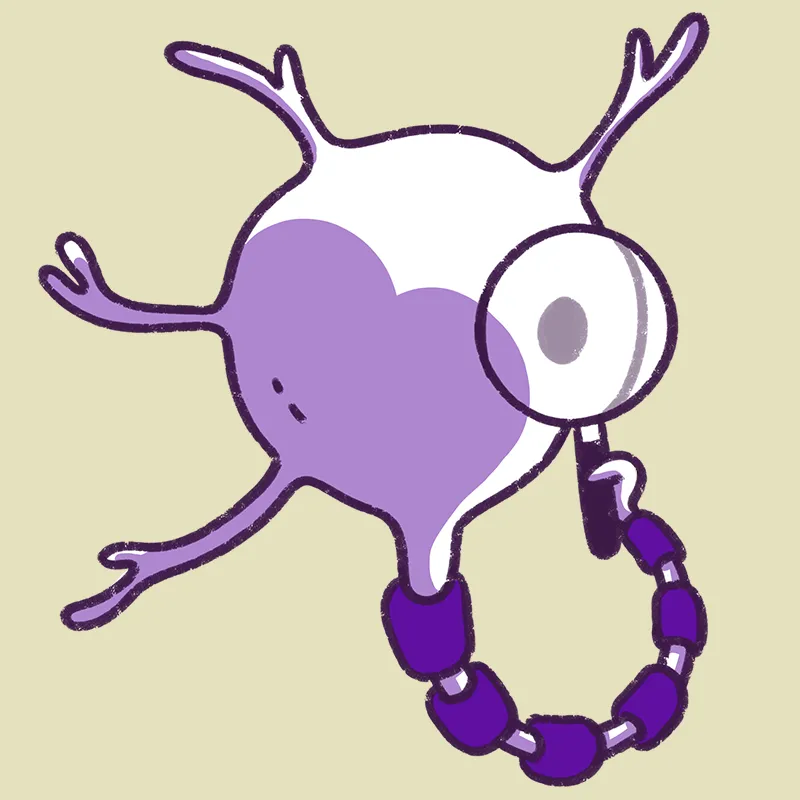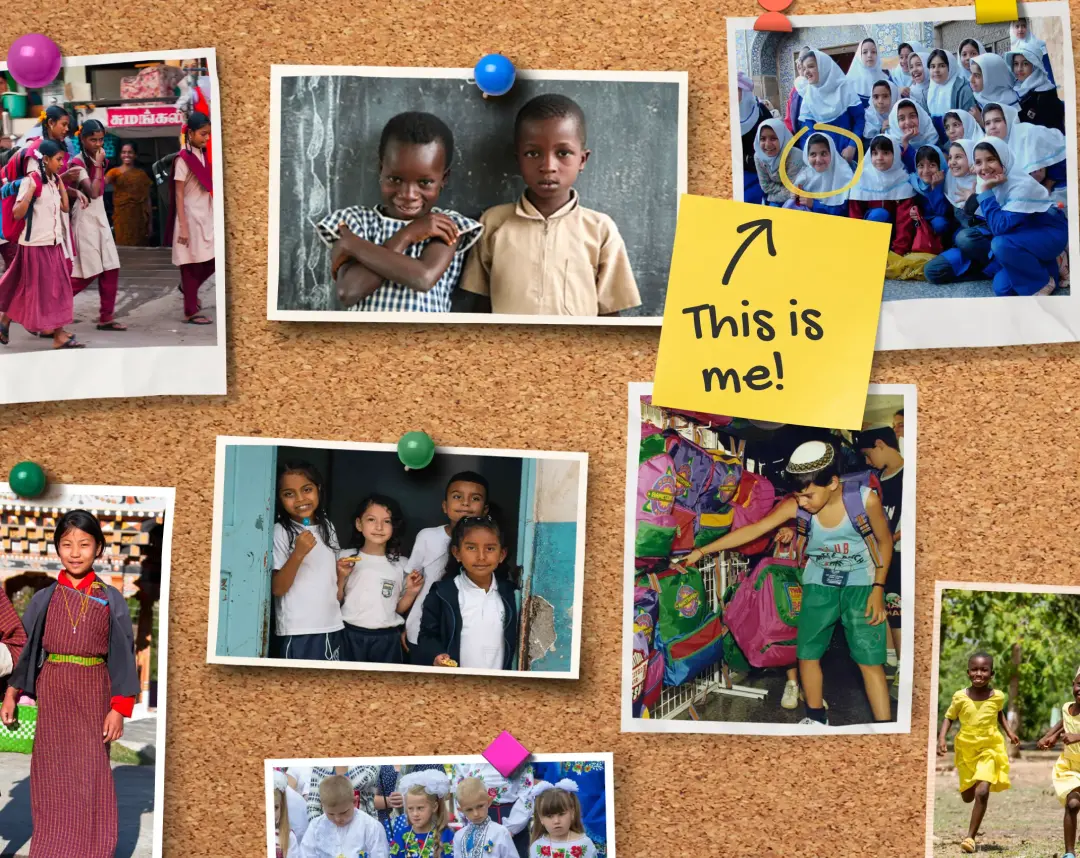How do we make memories?
What might that girl be thinking about? When you experience something, your brain remembers it by changing the connections between brain cells. It’s like taking a picture of that moment.
The more you think about it, the stronger the memory becomes. Some memories make us happy, while others make us feel sad or scared.

Not just a toy
Do you like playing with dolls, teddy bears, and toys? It helps you learn about feelings and how to be friends. Do you sometimes copy what you see grown-ups do?
It’s also wonderful to use your imagination to make up stories and magic worlds of your own where you can feel happy and explore new things, especially when times are tough.

Did
you
know
?

Young children’s memories are a mystery
Four-year-olds can learn a lot through repeated experiences. They might remember their daily routine at kindergarten – after lunch there’s storytime then naptime, for example. But they are not very good at remembering details from events, like who they sat next to at lunch yesterday. This is a mystery for scientists! Zoe Ngo, researcher

Do you have a favorite toy? What makes it special? Some keepsakes hold a special place in our hearts because they remind us of people, places, or experiences that we love and want to remember. Your favorite toy might also be special because it was the first thing that was truly yours!
Teddy bear tales
Discover the fascinating history behind the teddy bear and how it became a cherished toy for both children and adults.
A doll’s value is not in its price tag, but in the love with which it is cared for.
“The Doll”, French author Louise Boulanger

Price
This doll from 1890 cost $1 to make and sold for $10. Today, it’s worth $370. Why do you think it’s worth more today?

Emotions
Morton Bartlett spent his life creating life-size dolls. They were found after he died and are now shown in museums!

Fame
Toys owned or decorated by famous people can be very valuable. They can sell for more than 1000 times their original price!
Toys help us feel safe
Toys can make us feel better. They help us feel safe and comfort us when we’re sad or scared.
Because they’re like friends, teachers, and superheroes in one, they can help children and even adults understand their feelings and make sense of the world around them.


Girls in a war camp in Singapore made this quilt, weaving stories and feelings into its fabric and embroidering their names.

Memory vessels are special jugs decorated with things like toys or clocks. They help remember someone who has passed away.

Australian nurses helped World War II survivors make a rag doll from old prisoner uniforms. This helped them talk about their experiences.
Tell me about your memories!
Jeanne Wechsler survived World War II and tells the story of her Jewish family to schoolkids. Her doll reminds her of the happy times before the war and how not to give up when things get tough!

Living history projects
Want to know more?
Bibliography
Dolls, toys and teddy bears
Abate, M. A. (2017). Mickey Mouse as Teddy's Bear: The Political Cartoons of Clifford Berryman and the Origins of Disney's Iconic Character. Children's Literature Association Quarterly, 42(4), 396-416.
Carlson, L. (2006). Thomas Edison for Kids: His Life and Ideas, 21 Activities. Chicago Review Press.
Cross, G., & Smits, G. (2005). Japan, the US and the Globalization of Children's Consumer Culture. Journal of Social History, 873-890.
Feaster, P. (2015). ’Things Enough for so many Dolls to Say:’A Cultural History of the Edison Talking Doll Record. Thomas Edison National Historical Park. https://www.nps.gov/edis/learn/photosmultimedia/a-cultural-history-of-the-edison-talking-doll-record.htm
Habegger, U. (2020). Das Kinderdorf Pestalozzi in Trogen. GSK, Gesellschaft für Schweizerische Kunstgeschichte.
Hockenberry, D. (2002). 100 Years of Teddy Bears. Schiffer Book for Collectors.
Katz,G.(2015). Margarete Steiff: Die Biografie.Lauringer Verlag.
Klug, E. (1950). Weihnachtslieder von 8 [acht] Nationen aus dem Kinderdorf Pestalozzi, Trogen: Noel̈s de 8 nations du village d'enfants Pestalozzi Trogen. Canzoni di natale di 8 nazioni del villaggio dei bambini Pestalozzi Trogen. Kinderdorf Pestalozzi.
Kuznets, L. R. (1994). When toys come alive: Narratives of animation, metamorphosis, and development. Yale University Press.
Paley, V. G. (2014). Boys and girls: Superheroes in the doll corner. University of Chicago Press.
Ruchat, M. (2022). L’usage de l’enfant dans les récits publicitaires de la reconstruction éducative: L’exemple du Village d’enfants Pestalozzi de Trogen en Suisse 1944-1953. Revue d’histoire de l’enfance «irrégulière», (1), 85-100.
Walsh, T. (2005). Timeless toys: Classic toys and the playmakers who created them. Andrews McMeel Publishing.
Walsh, M. (1992). Plush endeavors: An analysis of the modern American soft-toy industry. Business History Review, 66(4), 637-670.
Zwierlein, A. J. (2019). Sonic Monstrosity and Visionary Women: Female Speaking Automata and Mass Mediation in Late-19th-Century British Science and Fiction. Anglistik: International Journal of English Studies, 30, 89-105.
von Allmen, K., & Henry, M. (2021). Der Traum einer Welt für Kinder: Das Kinderdorf Pestalozzi-seit 75 Jahren für Kinder, Bildung und Frieden. Appenzeller.
Winter, B. (2016). Talking Dolls. Michigan Quarterly Review, 55(4), 539.
Wosk, J. (2004). Edison's Eve: A Magical History of the Quest for Mechanical Life. Technology and Culture, 45(4), 897-899.
Childhood studies and popular culture
Aries, P. (2020). Centuries of childhood. In Toward a sociology of education (pp. 37-47). Routledge.
Boillat, A. (2010). On the singular status of the human voice: tomorrow’s eve and the cultural series of talking machines. Cinema beyond film: media epistemology in the modern era, 233-251.
Corsaro, W. A., & Everitt, J. G. (2023). The sociology of childhood. Sage publications.
Cunningham, H. (2020). Children and childhood in western society since 1500. Routledge.
DeMause, L. (1995). The history of childhood. Jason Aronson.
Dyson, A. H. (1997). Writing superheroes: Contemporary childhood, popular culture, and classroom literacy. Teachers College Press.
Fletcher, S. A. (2020). Exploring the History of Childhood and Play Through 50 Historic Treasures. Rowman & Littlefield.
Forman-Brunell, M. (1993). Made to play house: Dolls and the commercialization of American girlhood, 1830-1930. Yale University Press.
Johansson, B., & Brembeck, H. (1997). The Commercialization of Childhood. Ethnologia Europaea, 27(1), 15-28.
Hahn, S. (2019). Female Founders in der Games-und Medienbranche. Springer Berlin Heidelberg.
Messner, M. A. (2015). Barbie girls versus sea monsters: Children constructing gender. In Sociological Perspectives on Sport (pp. 100-114). Routledge.
Mitchell, C., & Reid-Walsh, J. (2005). Researching children's popular culture: The cultural spaces of childhood. Routledge.
Nama, A. (2011). Super black: American pop culture and black superheroes. University of Texas Press.
Prout, A. (2004). The future of childhood. Routledge.
Shuttleworth, S. (2010). The mind of the child: Child development in literature, science, and medicine, 1840-1900. Oxford University Press.
Memories and history projects
Couser, G. T. (2019). The Box in the Attic: Memoir, Methodology, and Family Archives. In Research Methodologies for Auto/Biography Studies (pp. 247-253). Routledge.
Perks, R., & Thomson, A. (2015). The oral history reader. Routledge.
Ritchie, D. A. (Ed.). (2012). The Oxford handbook of oral history. Oxford University Press.
Ritchie, D. A. (2014). Doing oral history. Oxford University Press.
Sitton, T., Mehaffy, G. L., & Davis, O. L. (2011). Oral history: A guide for teachers (and others). University of Texas Press.
Thompson, P. (2002). The voice of the past: Oral history. In The oral history reader (pp. 35-42). Routledge.
Yakel, E. (2004). Seeking Information, Seeking Connections, Seeking Meaning: Genealogists and Family Historians. Information Research: an international electronic journal, 10(1), n1.
Learning objectives
Based on Curriculum 21, German-speaking Switzerland, 2024.
The students ...
NMG 1.1 for 7+
1 b) can describe feelings and interests based on examples (e.g. in stories) and name differences and similarities.
NMG 11.3 for 7+
2 d) Can describe what is valuable and important to them and the people around them. Can distinguish between material and non-material values (e.g. possessions, friendship, memories, community history).






























